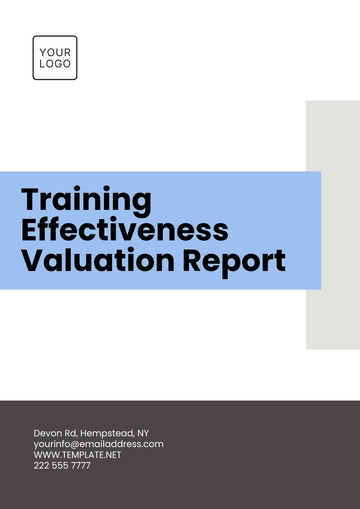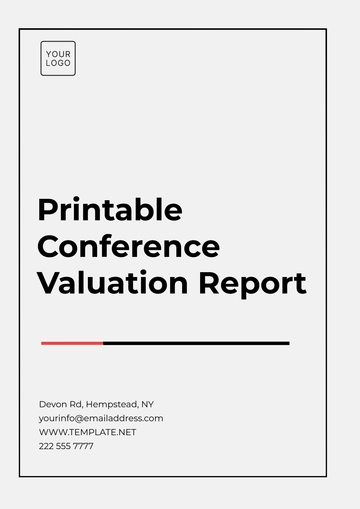Free Market Valuation Report

Introduction
The purpose of this report is to provide a comprehensive analysis of the current market valuation. It includes an assessment of various market sectors, evaluation of economic indicators, and an analysis of potential investment opportunities. The report aims to serve as a valuable resource for investors, analysts, and policymakers.
Executive Summary
This section provides a high-level overview of the market valuation findings, highlighting key areas of interest and summary conclusions drawn from the assessment. It outlines the main drivers of market performance over the assessment period and projects potential future trends based on current data.
Market Overview
In this section, we explore the current state of the market, covering major indices, trends, and investment environments. We analyze the impacts of geopolitical events, technological advancements, and regulatory changes on market dynamics.
Major Indices
The following table provides an overview of the performance of major stock indices:
Index | Performance (YTD) | 5-Year Trend |
|---|---|---|
S&P 500 | +15% | +68% |
NASDAQ | +20% | +83% |
Dow Jones | +12% | +50% |
Sector Analysis
Market sectors have shown varying degrees of growth and decline. This section identifies top-performing sectors and those experiencing downturns.
Technology: Continued robust growth fueled by innovation in AI and software.
Healthcare: Moderate growth with potential tied to aging demographics.
Retail: Mixed performance, with e-commerce growth offsetting traditional retail declines.
Economic Indicators
This section analyzes key economic indicators that influence market valuation. Indicators include GDP growth rates, inflation, unemployment rates, and consumer confidence indices.
Indicator | Current Value | 1-Year Change |
|---|---|---|
GDP Growth | 3.2% | +0.5% |
Inflation Rate | 2.1% | -0.4% |
Unemployment Rate | 4.8% | -0.7% |
Valuation Methodologies
This section covers the different methodologies used in assessing market valuation. Methods may include discounted cash flow analysis, comparative market analysis, and precedent transaction analysis. Each method offers unique insights into the valuation process.
Discounted Cash Flow Analysis
The discounted cash flow (DCF) approach evaluates the present value of expected future cash flows to determine the market valuation of a company or asset. This method is particularly useful for assessing intrinsic value.
Comparative Market Analysis
Comparative market analysis (CMA) involves reviewing similar companies or assets within the same industry to determine valuation benchmarks. This approach provides a relative valuation perspective.
Precedent Transaction Analysis
Precedent transaction analysis considers previously completed deals in the market to estimate valuation based on historical transaction data. This method offers insights into market trends and price points.
Investment Opportunities
In this section, we identify potential investment opportunities based on the current market valuation analysis. Opportunities are assessed across different sectors, with a focus on growth potential and risk management.
Emerging Markets
Emerging markets offer significant growth opportunities but come with increased risk. Asia and Latin America present promising areas due to technological development and expanding consumer bases.
Sustainable Investments
Investments focusing on environmental, social, and governance (ESG) criteria are gaining traction as investors seek sustainable and ethical opportunities. Companies with strong ESG track records may see valuation premiums.
Innovation-Driven Sectors
Sectors driven by innovation, such as biotechnology and renewable energy, continue to attract investment interest. These sectors promise substantial returns owing to their disruptive potential.
Conclusion
The market valuation report provides a detailed examination of current market conditions, evaluation methodologies, and potential areas for investment. By understanding these dynamics, stakeholders can make informed decisions to optimize their portfolios and capitalize on emerging trends.
- 100% Customizable, free editor
- Access 1 Million+ Templates, photo’s & graphics
- Download or share as a template
- Click and replace photos, graphics, text, backgrounds
- Resize, crop, AI write & more
- Access advanced editor
Craft a professional market valuation report with ease using this customizable and printable template offered by Template.net. Fully editable in our AI Editor Tool, this downloadable resource ensures precision and adaptability for your valuation needs. Perfect for businesses and analysts, it provides a seamless solution to create detailed, professional reports in minutes.
You may also like
- Sales Report
- Daily Report
- Project Report
- Business Report
- Weekly Report
- Incident Report
- Annual Report
- Report Layout
- Report Design
- Progress Report
- Marketing Report
- Company Report
- Monthly Report
- Audit Report
- Status Report
- School Report
- Reports Hr
- Management Report
- Project Status Report
- Handover Report
- Health And Safety Report
- Restaurant Report
- Construction Report
- Research Report
- Evaluation Report
- Investigation Report
- Employee Report
- Advertising Report
- Weekly Status Report
- Project Management Report
- Finance Report
- Service Report
- Technical Report
- Meeting Report
- Quarterly Report
- Inspection Report
- Medical Report
- Test Report
- Summary Report
- Inventory Report
- Valuation Report
- Operations Report
- Payroll Report
- Training Report
- Job Report
- Case Report
- Performance Report
- Board Report
- Internal Audit Report
- Student Report
- Monthly Management Report
- Small Business Report
- Accident Report
- Call Center Report
- Activity Report
- IT and Software Report
- Internship Report
- Visit Report
- Product Report
- Book Report
- Property Report
- Recruitment Report
- University Report
- Event Report
- SEO Report
- Conference Report
- Narrative Report
- Nursing Home Report
- Preschool Report
- Call Report
- Customer Report
- Employee Incident Report
- Accomplishment Report
- Social Media Report
- Work From Home Report
- Security Report
- Damage Report
- Quality Report
- Internal Report
- Nurse Report
- Real Estate Report
- Hotel Report
- Equipment Report
- Credit Report
- Field Report
- Non Profit Report
- Maintenance Report
- News Report
- Survey Report
- Executive Report
- Law Firm Report
- Advertising Agency Report
- Interior Design Report
- Travel Agency Report
- Stock Report
- Salon Report
- Bug Report
- Workplace Report
- Action Report
- Investor Report
- Cleaning Services Report
- Consulting Report
- Freelancer Report
- Site Visit Report
- Trip Report
- Classroom Observation Report
- Vehicle Report
- Final Report
- Software Report





























